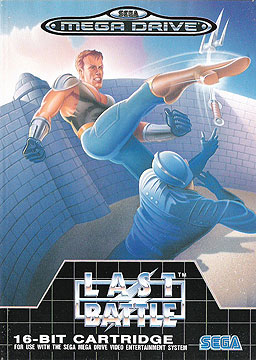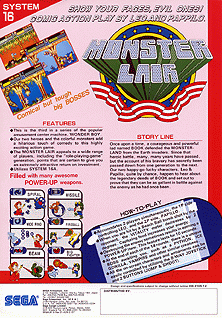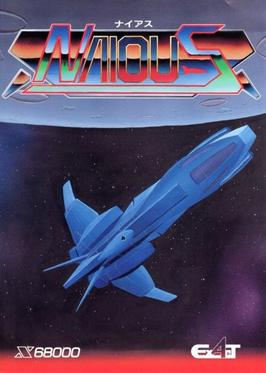
In video games, a boss is a significantly powerful non-player character created as an opponent to players. A fight with a boss character is commonly referred to as a boss battle or boss fight. Bosses are generally far stronger than other opponents the players have faced up to that point in a game. Boss battles are generally seen at climax points of particular sections of games, such as at the end of a level or stage or guarding a specific objective. A miniboss is a boss weaker or less significant than the main boss in the same area or level, though usually more powerful than the standard opponents and often fought alongside them. A superboss is generally much more powerful than the bosses encountered as part of the main game's plot and is often an optional encounter. A final boss is often the main antagonist of a game's story and the defeat of that character usually provides a positive conclusion to the game. A boss rush is a stage where players face multiple previous bosses again in succession.

E.V.O.: Search for Eden is a 1992 action-adventure game developed by Almanic Corporation and published by Enix for the Super NES. Combining traditional platforming mechanics with experience and leveling mechanics originating from role playing games, E.V.O.: Search for Eden involves the player navigating a creature through a number of side-scrolling levels while undergoing bodily evolution to cope with ever-changing environments. It is heavily based on Almanic's original title, 46 Okunen Monogatari ~The Shinka Ron~, released in Japan in 1990 for the PC-9801.

Ninja Gaiden III: The Ancient Ship of Doom is a side-scrolling platform video game developed and published by Tecmo. It was released in Japan on June 21, 1991 for the Famicom and in North America on August 1991 for the Nintendo Entertainment System (NES). The NES version was not released in Europe. It was later ported to the Atari Lynx by Atari Corporation and released in 1993 in North America and Europe, the European version retaining the North American Ninja Gaiden III title. It was also re-released as part of its Ninja Gaiden Trilogy Super NES compilation in 1995 in Japan and North America. Long after, it was released for the Virtual Console service in North America on February 18, 2008 for the Wii and in North America and Europe on November 28, 2013 and January 23, 2014 respectively for the Nintendo 3DS. It was designed by Masato Kato, who took over for Hideo Yoshizawa—designer of the first two games in the NES series.

Rygar is a 1986 side-scrolling platform game created by Tecmo. Originally released for Japanese arcades in June 1986, the game was subsequently ported to the NES (1987), Commodore 64 (1987), ZX Spectrum (1987), Amstrad CPC (1987), Master System (1988), Atari Lynx (1990), and X68000 (1994). Emulations have also been released for Xbox (2005), Sprint mobile phones (2005), Wii (2009), PlayStation 4 (2014), Nintendo Switch (2018), and Android (2023), with an unofficial fan-made emulation released for Amiga AGA in 2019. A remake, Rygar: The Legendary Adventure, was released for PlayStation 2 in 2002. The Legendary Adventure was remastered for the Wii in 2008 as Rygar: The Battle of Argus.

Metal Slug is a Japanese multimedia franchise and run and gun video game series originally created by Nazca Corporation before merging with SNK in 1996 after the completion of the first game in the series. Spin-off games include a third-person shooter to commemorate the 10th anniversary of the series and a tower defense game for the mobile platform. While originally created for Neo-Geo arcade machines hardware (MVS) and the Neo-Geo home game consoles (AES) hardware, the original games have also been ported to other consoles and mobile platforms throughout the years, with several later games created for various other platforms. The games focus on the Peregrine Falcon Squad, a small group of soldiers who fight against a rebel army, aliens, zombies, mummies and various other forces intent on world domination. Over the years since its debut, The franchise developed a small, but passionate cult following due to its unique visuals and slapstick humor.

Teenage Mutant Ninja Turtles, known as Geki Kame Ninja Den in Japan and Teenage Mutant Hero Turtles in Europe, is a 1989 side-scrolling action-platform game for the Nintendo Entertainment System released by Konami. In North America it was published under Konami's Ultra Games imprint in the US and the equivalent PALCOM brand in Europe and Australia.
Gradius is a series of shooter video games, introduced in 1985, developed and published by Konami for a variety of portable, console and arcade platforms. In many games in the series, the player controls a ship known as the Vic Viper.

Yokai Dochuki is a 1987 platform arcade game developed and released by Namco in Japan and other parts of Asia. The player controls a young boy named Tarosuke as he must make his way through Jigoku, the Japanese concept of Hell, to reach Buddha, who will determine his fate. Tarosuke can fire small "ki" bullets at enemies to defeat them; he can also charge them to increase their power. Enemies will drop money when defeated, which can be used to purchase weapons and other items in stores. Two versions of the arcade original were released: a Japanese version and an English version which was released in other Asian countries outside Japan. The Arcade Archives release includes both versions.

The Death and Return of Superman is a side-scrolling beat 'em up video game released by Sunsoft for the Super NES and Genesis in 1994. It is based on "The Death of Superman" comic book storyline by DC Comics and features many characters from the comics, including Superman himself, Superboy, Steel, Cyborg Superman, the Eradicator, and Doomsday. All of the five Supermen are playable characters at some point.

Last Battle: Legend of the Final Hero is a side-scrolling martial arts beat 'em up released for the Mega Drive/Genesis in 1989 by Sega. It was one of the six games that were available as part of the Genesis launch lineup in the U.S. The Japanese version, titled Shin Seikimatsu Kyūseishu Densetsu: Hokuto no Ken, is based on the manga and anime series Fist of the North Star. Since the international version did not retain the Hokuto no Ken license, the graphics and characters' names were altered. It was the second Hokuto no Ken game released by Sega, following the Mark III original, released internationally as Black Belt. Versions for the Commodore 64 and Amiga based upon Last Battle were developed and released by Elite in Europe in 1991.

Wonder Boy III: Monster Lair is a side-scrolling action game developed by Westone Bit Entertainment that was originally released for the arcades by Sega in 1988. It is the third game in the Wonder Boy series and the last one released for the arcade. A console adaptation was made by Hudson Soft, released in 1989 in Japan for the PC Engine CD-ROM² System and the subsequent North American release on the TurboGrafx-CD dropped the 'Wonder Boy III' title. It was also converted and released by Sega for the Mega Drive in Japan in 1990 and Europe in 1991. Both, the TurboGrafx-CD and Mega Drive versions have been re-released for the Wii Virtual Console.

Fist of the North Star is a side-scrolling action video game produced by Toei Animation and developed by Shouei System for the Nintendo Entertainment System (NES). It was first released in Japan under the title Hokuto no Ken 2 on April 17, 1987, being the second Hokuto no Ken video game released for the Family Computer (Famicom) by the anime production company, while also serving as a tie-in to the Hokuto no Ken 2 anime series which began airing on Fuji TV a few weeks earlier. Taxan published the localized NES version in April 1989, making it one of the earliest Fist of the North Star products released in the U.S. alongside Viz Communications' English adaptation of the manga.

Somer Assault, known as Mesopotamia in Japan, is a video game developed and published by Atlus in 1991 for the TurboGrafx-16. This side-scrolling action game features an unnamed pink Slinky object/creature as the protagonist which can fire bullets from its sides, jump, and slink along walls in its quest to stop an evil sorceress. The title is a play on the word somersault, as the Slinky somersaults around the stage while assaulting enemies.

Bishōjo Senshi Sailor Moon: Another Story is a role-playing video game developed and published by Angel exclusively for the Super Famicom in Japan on 22 September 1995. Based upon Naoko Takeuchi's Sailor Moon shōjo manga and anime series, the game takes place between the third season and fourth season of the anime series, which adapted the third and fourth arcs of the manga respectively, as players take control of either the five Inner Guardians or the four Outer Guardians in order to protect Crystal Tokyo by fighting against a group of rebels and several of their previously defeated enemies once again that were resurrected by the sorceress Apsu.

Darwin 4078 is an arcade game released by Data East in 1986. The game is a vertical scrolling shoot 'em up like Xevious, but as the title indicates, Charles Darwin's theory of evolution is incorporated into the gameplay.

Super Star Force: Jikūreki no Himitsu is a video game developed and published by Tecmo on November 11, 1986 for the Family Computer only in Japan.

Godzilla is a 2014 video game developed by Natsume Atari and published by Bandai Namco Games for the PlayStation 3 and PlayStation 4 based on the Japanese monster Godzilla franchise by Toho. It was first released on December 18, 2014, in Japan only for the PlayStation 3. It was released on July 14, 2015, in North America and on July 17, 2015, in Europe. The Western PlayStation 4 version is based on the upgraded Japanese release called Godzilla VS, released on July 14, 2015, containing more content such as additional monsters.

Étoile Princesse is an action role-playing video game developed and published by Exact exclusively for the X68000 in Japan on March 26, 1993. It is the third title to be created and released by Exact for the X68000 platform late into its commercial life span, which was a few months before being discontinued in the same year by Sharp Corporation.

Naious is a scrolling shooter video game developed and published by Exact exclusively for the Sharp X68000 in Japan on October 26, 1990. It is both the first title to be created and released by Exact for the X68000 platform, as well as the first project produced by the company.

Bishōjo Senshi Sailor Moon R is a side-scrolling beat 'em up video game developed by Angel and published by Bandai in Japan on December 29, 1993. It is the third game to be created by Angel based upon Naoko Takeuchi's Sailor Moon shōjo manga and anime series, as well as the second title in the franchise for Super Famicom, serving as the sequel to Sailor Moon.



















